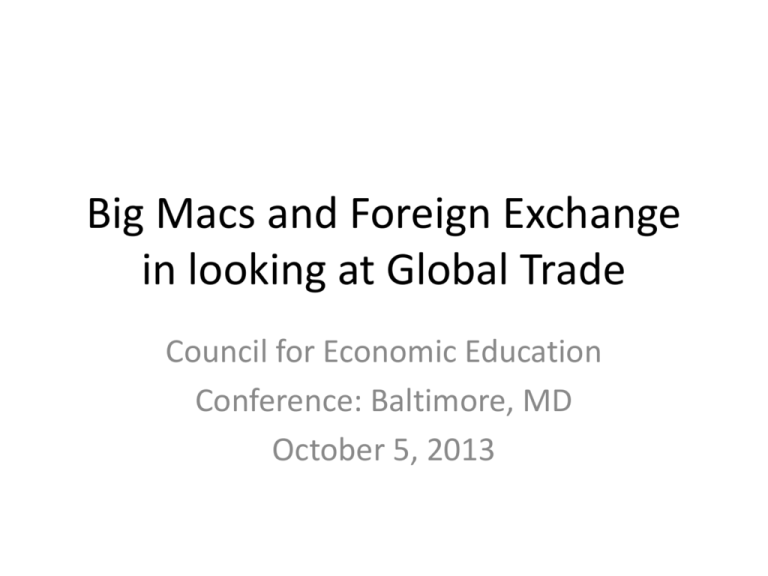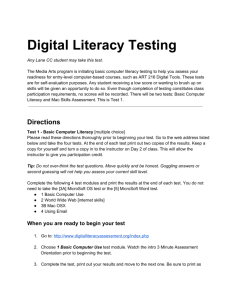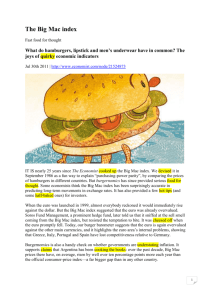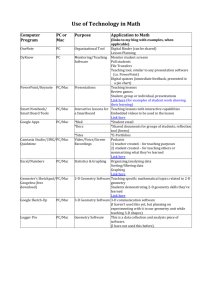Big Macs and Foreign Exchange in looking at Global Trade
advertisement

Big Macs and Foreign Exchange in looking at Global Trade Council for Economic Education Conference: Baltimore, MD October 5, 2013 International prices and wage comparisons • A tricky area indeed to understand as well as to teach • A look at PPP • Purchasing- power parity • How we use it? • Why use it? • Link it to class and topics in studying global trade, for both AP economics and economics Burgernomics! • The Economist has used the BIG MAC for years as its way to analyze foreign exchange rates • As they put it, the ‘secret sauce’ of their analysis is the theory of purchasing-power parity. • Which begs the question, what is purchasingpower parity? Our basket of good and service to analyze has just ONE item: BIG MAC! Purchasing-power parity • It is looking at two nations currencies at the “nominal” exchange rate at which a given market basket of goods and services would cost the same amount in each nation. • Instead of using a market basket of a variety of goods and services, the Big Mac index uses one: • The Big Mac! ( Except in India…) Why look at the Big Mac index? • It is useful and an easier way to illustrate a key area in open economies or studying the foreign exchange market • International exchanges require a market—the foreign exchange market—in which currencies can be traded for each other. • The price at which these trades are made are known as the exchange rate. S$ Yen/$ $/Yen SYen D$1 SYen1 D$ DYen USD Yen Currency Markets Supply and Demand • Let’s take a look at foreign exchange rates and use this activity: • THE FOREIGN EXCHANGE MARKET 1. Skim over the first side of this APE handout. 2. Working together ( if possible ) and use your brain or calculator-----find the changes in currency values from May to August and see if 3. the currency APPRECIATED or DEPRECIATED! Some observations to be noted.. • When a currency appreciates or depreciates, it changes the price of imports and exports. • Why is this critical to understanding foreign trade? • Depreciation or appreciation of a currency will impact the economy since it impacts net exports. So, is there another way to look at this issue of exchange and currency values? • Yes, why yes there is! • Let’s look at the BIG MAC! Let’s compare using the Big mac index • We will look at a few nations to see whose currency is under or over valued against the dollar ( BIG MAC ) • Volunteers? • Let’s put them in order with the US in the middle to represent the average base price of the sandwich • Use handout A to see the table and let’s put these volunteers in their place! Results? • Which nations are above ( overvalued ) v the Big Mac? • Which nations are below ( undervalued ) v the • Big Mac? • What is the average price in the US? • Highest one in our simulation? On the chart? • Lowest one in our simulation? On the chart? Let’s go to real time and calculate the prices and see who is over or under valued? • Using the activity from EconEdLink, we are going to use current prices, world capitals and Big Macs to look at selected currencies. • 1. Work with a partner • 2 In our session, we can use a calculator ( but in class, decide if you want to or not ) • 3. We are going to look at 10 nations, capitals and currencies Using these nations, what are their capital cities? • • • • Australia? Denmark? Argentina? Mexico? • • • • • Sweden? Malaysia? Italy? Thailand? Hungary? And the answers are: • • • • Australia ( Canberra ) Denmark ( Copenhagen) Argentina ( Buenos Aires) Mexico ( Mexico City ) • • • • • Sweden ( Stockholm ) Malaysia ( Kuala Lumpur) Italy ( Rome ) Thailand ( Bangkok) Hungary ( Budapest ) As we move to end this session, let us consider….. • Purchasing power parity is a theory and model of exchange rate determination. • The Big Mac index developed by The Economist is a fun way to study a tradable good and prices between locations in different nations. • It can add to your teaching of exchange rates and open economies/global trade Suggestions for additional resources • The Economist. Search their website for more as well as print issues ( www.economist.com ) • www.econedlink.org/lessons for the lesson on the Big Mac index • Youtube.com has several clips on purchasing power parity for you as a teacher to look over for enrichment or learning Textbooks • Krugman’s Macroeconomics for AP. Ray, Anderson, Krugman and Wells. BFW Worth. 2013. Pages 427-428. • Economics: Principles in Action. Sullivan and Sheffrin. Prentice Hall. 2008. pages 458-461. APE materials to consider • Advanced Placement Macroeconomics: Student Resource Material. • Lesson 7-3. • CEE. 2012 Thank you for your time and effort in this session • Hopefully you have a better sense of the Big Mac index, purchasing power parity and foreign exchange rates from today • You can do this • Do good things daily • It is about progress over time • Contact me? • Bruce Damasio at Maryland Council on Economic Education. ( Towson U ) bdamasio@towson.edu • Take care and thanks again for coming this morning!




